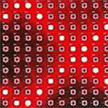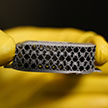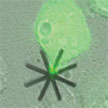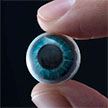Showing Spotlights 33 - 40 of 235 in category All (newest first):
 Researchers demonstrate a multitarget real-time trajectory tracking system by using a time-division position sensitive detector (TD-PSD) system by employing a graphene-silicon Schottky heterojunction. The system allows for multi-target real-time trajectory tracking with a maximum image output frame rate of up to 62 000 frames per second (which is superior to commercial optical high-speed motion capture systems of about 1000 frames per second). This breaks the bottleneck in precise high-speed trajectory tracking and multi-target detection of traditional position sensitive detectors.
Researchers demonstrate a multitarget real-time trajectory tracking system by using a time-division position sensitive detector (TD-PSD) system by employing a graphene-silicon Schottky heterojunction. The system allows for multi-target real-time trajectory tracking with a maximum image output frame rate of up to 62 000 frames per second (which is superior to commercial optical high-speed motion capture systems of about 1000 frames per second). This breaks the bottleneck in precise high-speed trajectory tracking and multi-target detection of traditional position sensitive detectors.
Oct 10th, 2022
 New research describes the first example of self-powered bioelectronics on a mask that can measure the biological glucose signal with continuous energy. In their work, the researchers demonstrate a 3-in-1 mask device that can 1) harvest energy (a biofuel cell); 2) store energy (a supercapacitor); and 3) indicate glucose concentration (a biosensor). The small biofuel cells can harvest energy from the sweat on a person's face and indicate the level of the analyte that tracks health and nutrition.
New research describes the first example of self-powered bioelectronics on a mask that can measure the biological glucose signal with continuous energy. In their work, the researchers demonstrate a 3-in-1 mask device that can 1) harvest energy (a biofuel cell); 2) store energy (a supercapacitor); and 3) indicate glucose concentration (a biosensor). The small biofuel cells can harvest energy from the sweat on a person's face and indicate the level of the analyte that tracks health and nutrition.
Sep 19th, 2022
 Researchers have developed a sprayable on-site sensing tool. The main application area for this sensor spray is the detection of specific analytes in an environment where sample collection is a difficult task either due to the target chemicals themselves or the area where the samples are located. A nebulization method allows for nanofibers to be sprayed onto any surface, while the accompanying phone-based application allows for direct on-site detection.
Researchers have developed a sprayable on-site sensing tool. The main application area for this sensor spray is the detection of specific analytes in an environment where sample collection is a difficult task either due to the target chemicals themselves or the area where the samples are located. A nebulization method allows for nanofibers to be sprayed onto any surface, while the accompanying phone-based application allows for direct on-site detection.
Jun 27th, 2022
 Researchers propose a first-of-a-kind smart orthopedic implant with both diagnostic and energy harvesting capabilities. This mechanically tunable, multifunctional metamaterial implant can sense and harvest energy from body motions. These implants only use their constituent components to achieve these advanced functionalities - they don't require any external power source or bulky electronics. Furthermore, the implants can be 3D printed and customized for each patient based on the clinical requirements and anatomical matching.
Researchers propose a first-of-a-kind smart orthopedic implant with both diagnostic and energy harvesting capabilities. This mechanically tunable, multifunctional metamaterial implant can sense and harvest energy from body motions. These implants only use their constituent components to achieve these advanced functionalities - they don't require any external power source or bulky electronics. Furthermore, the implants can be 3D printed and customized for each patient based on the clinical requirements and anatomical matching.
Jun 3rd, 2022
 Researchers have designed a self-powered, 'one-terminal' tactile sensor that can distinguish various motions on a single electrode. They did this by using a thermoplastic polymer that can easily change the electrostatic signal in a selective area. The sensor array can perceive the position and the sequence of touches, shape of touching objects, and dynamic motions (sliding, rolling) of an object and can distinguish various motions on a single electrode.
Researchers have designed a self-powered, 'one-terminal' tactile sensor that can distinguish various motions on a single electrode. They did this by using a thermoplastic polymer that can easily change the electrostatic signal in a selective area. The sensor array can perceive the position and the sequence of touches, shape of touching objects, and dynamic motions (sliding, rolling) of an object and can distinguish various motions on a single electrode.
May 6th, 2022
 The mechanical properties of cells and their intracellular mechanical loads are as relevant for a cell's accurate functioning as the biochemical portion of the cell. This offers a novel perspective that addresses the study of cell mechanics and even the alteration of the mechanical equilibrium of the cells by using silicon chips as an intracellular intervention mechanism. These 'echanical drugs' open the possibility to determine and measure intracellular forces and internalization routes. They can also produce intracellular mechanical perturbations by altering the cell cycle and even, if they are designed accordingly, destroy the cells.
The mechanical properties of cells and their intracellular mechanical loads are as relevant for a cell's accurate functioning as the biochemical portion of the cell. This offers a novel perspective that addresses the study of cell mechanics and even the alteration of the mechanical equilibrium of the cells by using silicon chips as an intracellular intervention mechanism. These 'echanical drugs' open the possibility to determine and measure intracellular forces and internalization routes. They can also produce intracellular mechanical perturbations by altering the cell cycle and even, if they are designed accordingly, destroy the cells.
May 2nd, 2022
 Ongoing smart contact lens research ranges from biosignal detection (intraocular pressure, glucose, cortisol) to therapeutic tools (aniridia, chronic ocular inflammation) and advanced features such as aumented reality displays and personalized designs using 3D-printing technology. Some of these technologies are already finding their way from the lab into commercial applications. The development of next-generation, smart contact lens technology is not just simply one field of bioelectronics but rather a complex, interdisciplinary effort that includes development of biocompatible materials; development of intuitive interfaces; and development of integration technologies capable of smart contact lens research.
Ongoing smart contact lens research ranges from biosignal detection (intraocular pressure, glucose, cortisol) to therapeutic tools (aniridia, chronic ocular inflammation) and advanced features such as aumented reality displays and personalized designs using 3D-printing technology. Some of these technologies are already finding their way from the lab into commercial applications. The development of next-generation, smart contact lens technology is not just simply one field of bioelectronics but rather a complex, interdisciplinary effort that includes development of biocompatible materials; development of intuitive interfaces; and development of integration technologies capable of smart contact lens research.
Apr 18th, 2022
 Resonance-based sensors can be used as an advanced tool for gas sensing as they show several advantages as compared to conventional gas sensors like metal-oxide semiconductor and electro-chemical gas sensors. With the introduction of an additional metamaterial layer over the sensor, the selectivity of these sensors can be improved. These article focuses mainly on metamaterial-based split ring resonators (SRR) and complementary SRRs (CSRRs) structures used in several sensing applications.
Resonance-based sensors can be used as an advanced tool for gas sensing as they show several advantages as compared to conventional gas sensors like metal-oxide semiconductor and electro-chemical gas sensors. With the introduction of an additional metamaterial layer over the sensor, the selectivity of these sensors can be improved. These article focuses mainly on metamaterial-based split ring resonators (SRR) and complementary SRRs (CSRRs) structures used in several sensing applications.
Apr 7th, 2022
 Researchers demonstrate a multitarget real-time trajectory tracking system by using a time-division position sensitive detector (TD-PSD) system by employing a graphene-silicon Schottky heterojunction. The system allows for multi-target real-time trajectory tracking with a maximum image output frame rate of up to 62 000 frames per second (which is superior to commercial optical high-speed motion capture systems of about 1000 frames per second). This breaks the bottleneck in precise high-speed trajectory tracking and multi-target detection of traditional position sensitive detectors.
Researchers demonstrate a multitarget real-time trajectory tracking system by using a time-division position sensitive detector (TD-PSD) system by employing a graphene-silicon Schottky heterojunction. The system allows for multi-target real-time trajectory tracking with a maximum image output frame rate of up to 62 000 frames per second (which is superior to commercial optical high-speed motion capture systems of about 1000 frames per second). This breaks the bottleneck in precise high-speed trajectory tracking and multi-target detection of traditional position sensitive detectors.
 Subscribe to our Nanotechnology Spotlight feed
Subscribe to our Nanotechnology Spotlight feed





